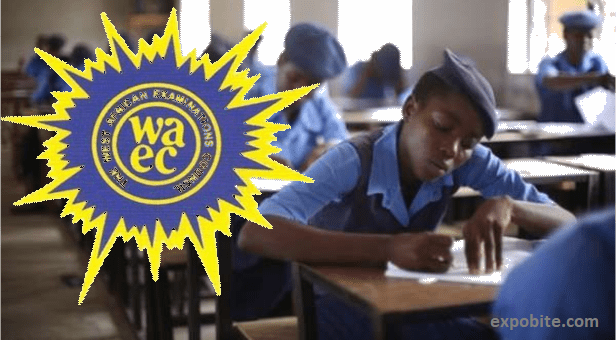Waec Hausa 2022 Answers for 1st June
Waec Hausa Answers 2022. Let me send you 100% verified and correct Waec Hausa Answers 2022 for the 1st of June 2022 directly to your mobile phone, via WhatsApp, SMS, or through our website expobite.net/answer page.
HAUSA-ESSAY ANSWERS ANSWERS
(1)
KUDA WAJEN KWADAYI AKAN MUTU
An yi wani mutum da ya shahara wajen neman mata, don kuwa abokansa har wani kirari suke ma sa wai “kuda ba ka haram”. Ba komai ya sa suke ma sa wannan kirari ba illa duk inda ya ga mace sai ya takale ta da zancen banza.
Ganin yadda al’amarin abokinsu ya ta’azzara wadanda za su iya daga cikin abokansa, suka dauki gabarin ba shi shawara kan ya guji neman mata saboda illolin dake tattare da aikata hakan, saboda tarin zunubi da a kullum yake kwasa, kuma ga shi ba’a sanar da bawa lokacin mutuwarsa balle ya tuba kafin lokacin, baya ga cututtuka da ake dauka sakamakon wannan mummunan aiki, amma duk da haka ya yi kunnen uwar shegu da su.
Wata rana ya shiga wani wajen sayar da abinci don ya cika cikinsa, zamansa ke da wuya, sai wata mace ta shigo don ta sayi abinci, akai dace ta zauna kusa da shi, kowannen su ya fadi abincin da yake bukata aka kawo ma sa.
Bayan sun kammala cin abincin sai ya dauko kudi ya ce, a dauki na sa da kuma na wannan mata, ko da ta ji haka, sai ta ce, a’a ya kyale shi za ta biya, sannan ta yi ma sa godiya. Amma duk da haka gogan naka ya nace shi sai ya biya kudin, daga karshe da ta ga ba yadda ta iya sai ta hakura ya biya.
Ta nufi kofar fita, ya biyo ta ya ce, ta zo ya kai ta inda za ta je,a motarsa, sai ta shaida ma sa cewa a motarta ta zo, sai ya ce, to tunda kin ki shiga tawa motar, ke rage min hanya a motarki, sai ta ce ya shiga.
Shigarsa motar ke da wuya, ta tayar da ita suka runtuma, ba ta tsaya a ko ina ba, sai wani barikin sojoji dake garin. Isar su bakin kofar shiga, ya ga an bude ma ta kofa da sauri, ta na zuwa kofar wani gida ta yi fakin da motar ta shiga gida. Ashe matar wani babban soja ce a wannan bariki.
Ta na shiga gida akai sa’a mijin na ciki, sai ta ba shi labarin yadda su ka yi da wannan manemin mata. A nan fa soja ya fito, ya umarci wasu kuratan soja kan su kawo shi gabansa ya na falo a zaune.
Ko da ya shigo falo jikinsa na rawa, sai mijin matar ya tambaye shi, “Me ne ne hadinka da mata ta ? Saboda tsabar kyarmar jiki ya gagara ba shi amsa. Can fa soja ya tafasa ransa ya baci, ya daka ma sa tsawa ya ce, “To me ya kawo ka gidana ?. Sai kawai ya ce karar kwana !.
Ko da sojan ya ji haka sai ya bushe da dariya, ya ce, da kuratan sojan su raka shi kofa. To sai dai hausawa na cewa, “Ba’a bari a kwashe dai-dai”, sojojin nan su ka ce, ba za su yi rakiyar banza ba, sai da suka ba shi na jaki sannan su ka iza keyarsa su ka ce, nan gaba ma ya kara.
Ai kuwa tun daga wannan rana ko abokansa sun ce “Kuda ba ka haram” sai ya ce da ke nan.
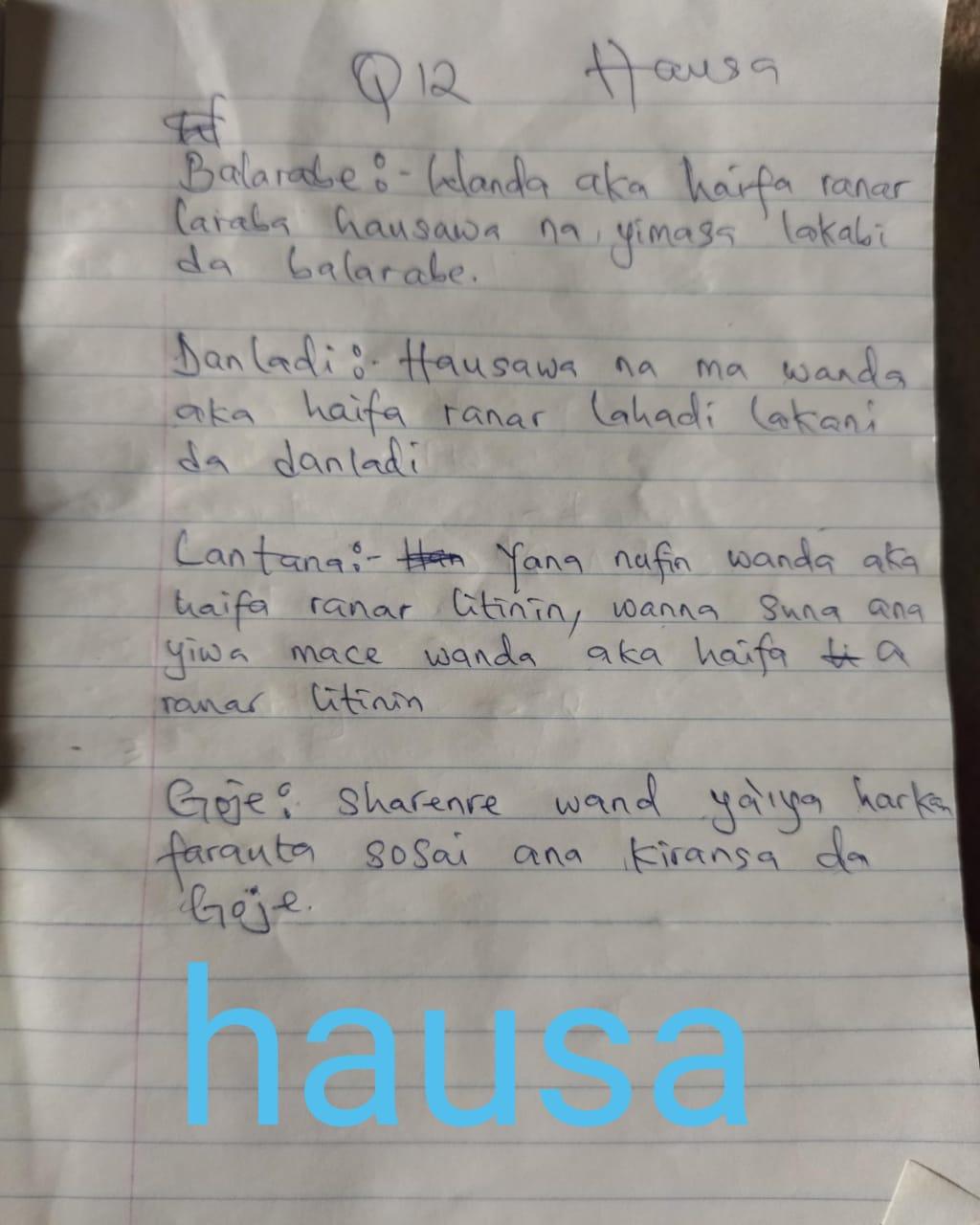
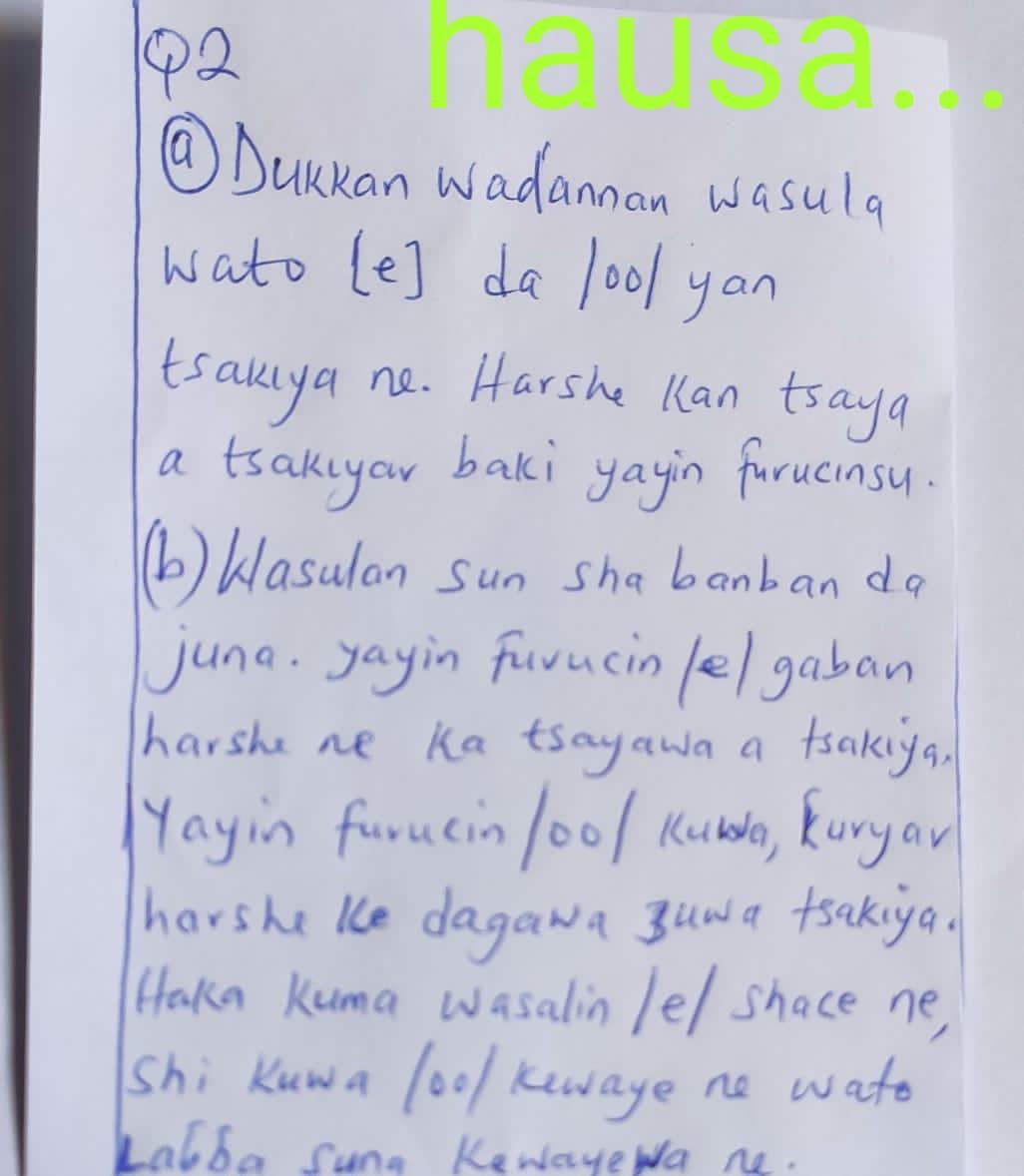
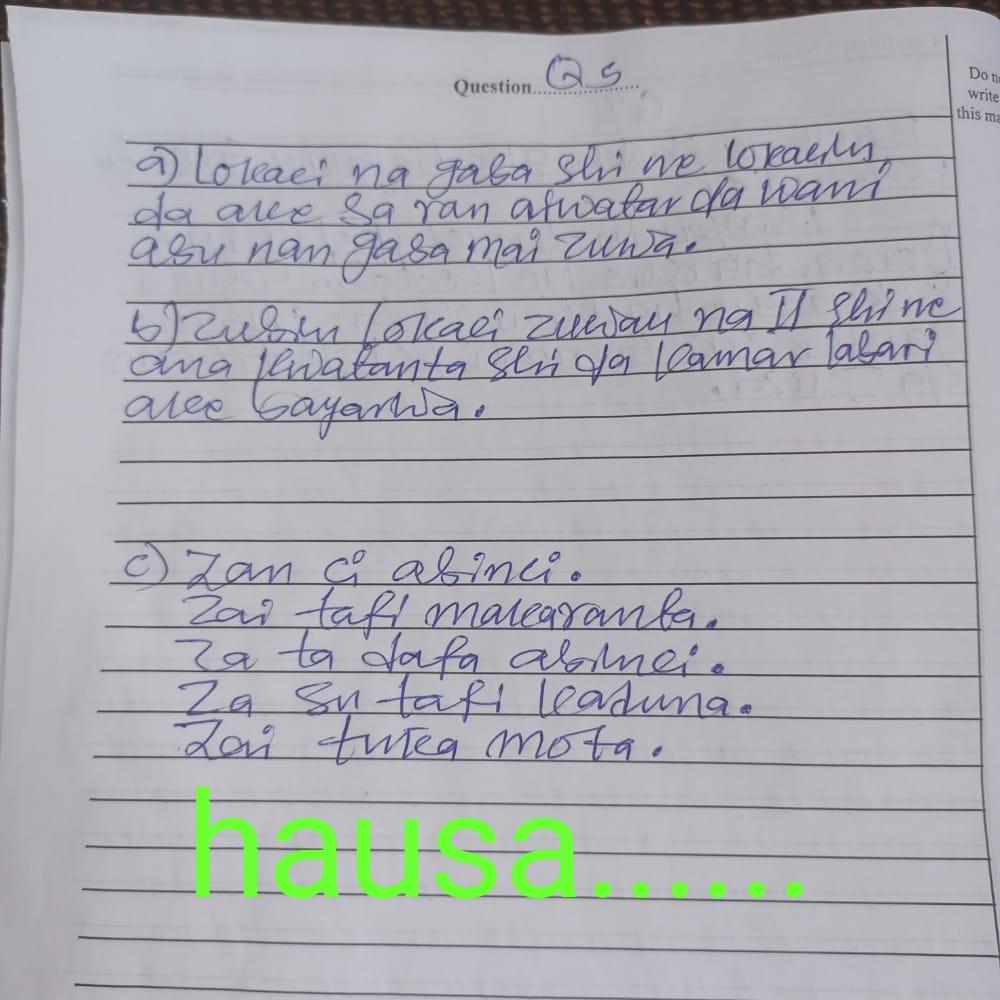


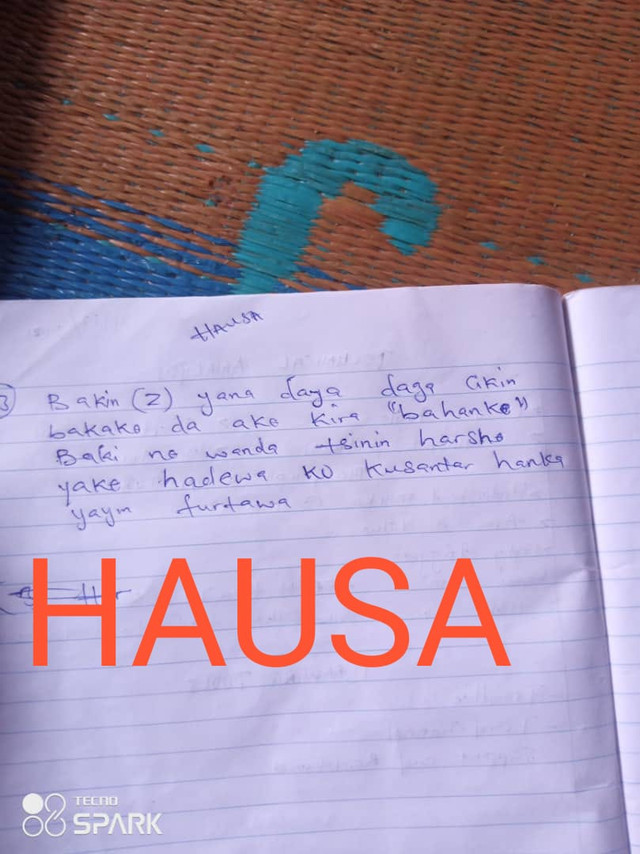

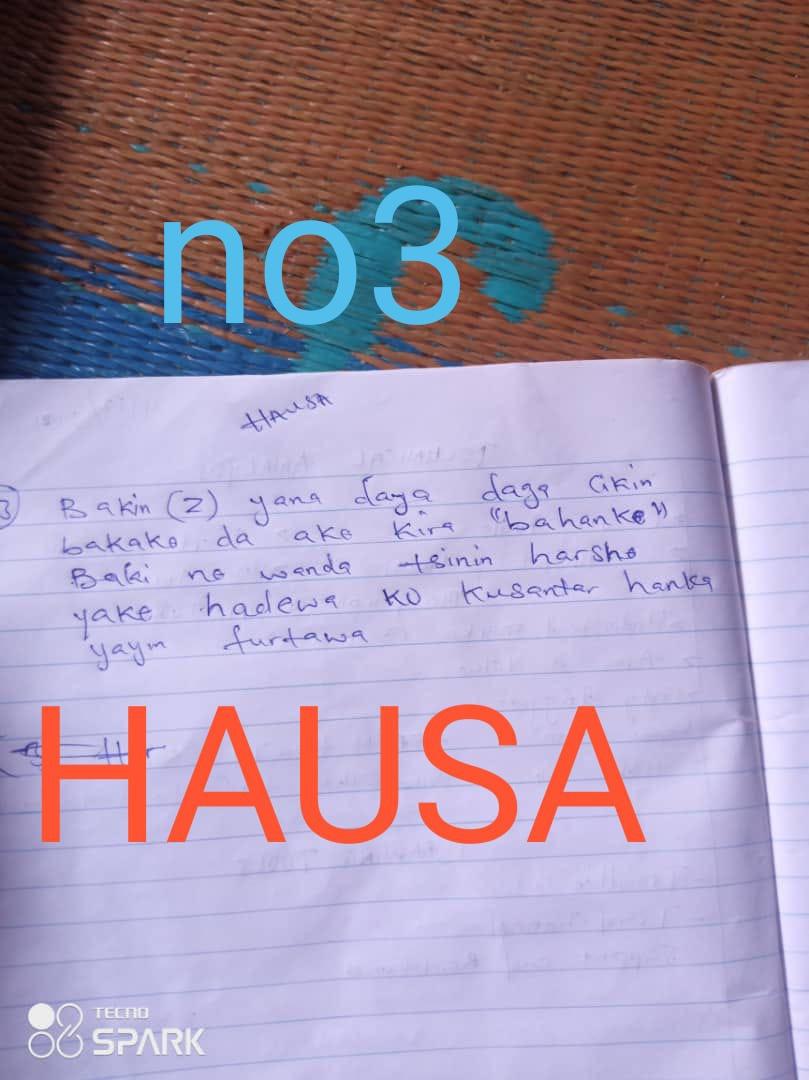
Here are the objective and essay answers for Waec 2022 May/June examination, Hausa is one of the underrated subjects in the Waec examination, but believe me, to pass and get an A in this particular subject is not really easy unless you are ready to take the necessary steps, and I think you landed on this page because you want to seek for Waec Hausa exam help.
Expobite is the most trusted website out there on the internet and the best place to get Waec Hausa questions and answers for the year 2022.
Are you a teacher, a student, a school owner, or do you manage an exam center and you want your candidates to make an A in this particular subject? subscribe with us right now without wasting time, the exam is about to start, and we will send you the 100% verified questions and answers for Waec 2022 Hausa examination.
Waec Hausa Questions and Answers 2022
Most times, people do ask me on WhatsApp if I can send them the questions along with the answers, and my answer is always “YES WE DO”, we do send questions and answers to our candidates unlike other sources that do send just answers and most times their answers turns out to be wrong, we will be sending you the 100% verified correct Waec Hausa answers 2022 directly to your mobile phone, through WhatsApp, text message or via Expobite answer page.
Waec Hausa 2022 Exam Date
The Waec Hausa 2022 examination has been scheduled to hold on Wednesday 1st May 2022 from 2:00 pm to 5:00 pm for both essay and objective.
| Paper | Start Time | End Time |
|---|---|---|
| Hausa 2 (Essay) | 2:00pm | 4:00pm |
| Hausa 1 (Objective) | 4:00pm | 5:00pm |
Countdown to Hausa Exam 2022
Below shows the time remaining for the exam to start, I don’t think you still have enough time
Subscribe with us now let’s help you pass this exam, this is one of the most important subjects as a Waec candidate, and failing it nullifies all other subjects you have written and are about to write.
Waec Hausa Runz 2022 Expo
Do you want to score an A in this 2022 Waec TD exam? then Expobite is just the right source for you to achieve this with ease, our track record speaks for us, for years now we have been into this, and we haven’t received single bad news at all of a failed candidate, unless for schools that their papers are canceled/withheld, I believe that’s a general issue from the school, it has nothing to do with us.
Below, we will show you how to subscribe with us so that we can send you the correct answers for your Waec Hausa exam.
How to Subscribe and Get Questions and Answers for Waec Hausa 3hrs Before the Exam
We have 3 methods of sending answers which you need to choose from and they are as follows:
| METHOD | PRICE |
|---|---|
| Pin/Password | ₦500 MTN Card |
| Direct WhatsApp | ₦600 MTN Card |
| Direct SMS | ₦1,500 MTN Card |
How to Subscribe for Waec Hausa Runz 2022 Using MTN Recharge Cards
- Choose your preferred answer delivery method.
- Buy an MTN card worth that amount (we accept 100, 200, 500, and 1000 MTN recharge cards)
- Type the recharge pins, subject, and answer delivery method you choose in a text message and send to 07062154881, eg. 623389393836329023, 634634930959858595, 0848746639287363, 35637372892848463, Hausa, WhatsApp, then send to 07062154881.
- Now we will load the recharge cards, then add you to the Hausa VIP WhatsApp group where we will send all the correct verified answers 3hrs before the exam starts, if you choose PIN, we will send you a 3digits PIN to unlock the Expobite Answer page where you will see the answers too before the exam starts.
How to Subscribe for Waec Hausa Runz 2022 Through Bank Transfer
Yes, we accept bank transfers of MTN airtime, if you have a bank account you can as well recharge us from your bank, then send a payment screenshot to us on WhatsApp at 07062154881, then send us your subject, and we will add you to the VIP answer group immediately.
How Can I Trust Expobite? This Is My First Time
Yes, I understand your fear, yes there are many scam exam sites online, and because of this, you just need to be careful, but I give you my word, Expobite is very trusted, we have been in this business for 4years now and we are not ready to trade our hard-earned reputation for anything.
Below is just a screenshot of the Marketing exam answers of 17th May 2022 we sent to our WhatsApp VIP group for our VIP candidates in 2022:

Hello, welcome to the Expobite Waec exam help center.
The Waec 2022 examination started on the 9th of May 2022.
Waec examination is tough and I know you wouldn’t like to still wear your secondary school uniform next year to rewrite Waec, that would be a very shameful thing.
Don’t make this very big mistake, a wrong decision you make now can make you rewrite Waec next year, we are here to help you pass your Waec examination once and for all at a very low price.
Are you a Waec 2022 candidate wishing to score A’s in the ongoing Waec examination? Then rush now and subscribe to our legit Waec 2022 exam help/runz expo before it’s too late.
Our Price List for 2022 Waec Runz
- Waec Runz for Science Students: ₦6,000 for 9 subjects including practicals.
- Waec Runz for Art Students: ₦6,000 for 9 subjects.
- Waec Runz for Commercial Students: ₦6,000 for 9 subjects
- Waec Runz Per Subject: ₦600, ENGLISH, and MATHS ₦1000 each.
- Waec Runz Per Practical: ₦500 per practical.
🔥 We Send All Questions and Answers 3hrs Before the Exam 🔥
PAYMENT METHOD: MTN recharge card/bank airtime transfer.
You can send the recharge pins via SMS or transfer the airtime to 07062154881
All answers will be sent to you via our VIP WhatsApp group.
You will be added to our VIP group immediately after you subscribe.
😃 SUBSCRIPTION IS ONGOING.
Subscribe now before it’s too late.
Past Hausa Questions and Answers Provided by Expobite
We have been in this since 2014 till date and all these years we have been providing exam candidates with the correct answers to all their exams, below, I will be sharing with you answers from past exams posted here on Expobite.net:
HISTORY OBJ
01-10: AACCCCCBDA
11-20: BBAAAAAADD
21-30: DDDDDCACBB
More coming
HISTORY ESSAY
SECTION A
(2)
(i) Subsistence and Commercial Activities:
Agriculture is the main economic activity. Grain is the staple diet, including Guinea corn, millet, maize, and rice. The Hausa also grow and eat root crops and a variety of vegetables. Cotton and peanuts are processed and used locally, but part of the harvest is exported. The Hausa practice intercropping and double-cropping; their main implement is the hoe.
(ii) Industrial Arts:
There are full-time specialists only where there is an assured market for craft products. Men’s crafts include tanning, leatherworking, saddling, weaving, dying, woodworking, and smithing. Iron has been mined, smelted, and worked as far back as there are Hausa traditions.
(iii) Trade:
Trade is complicated and varied. Some traders deal in a particular market, as distinguished from those who trade in many markets over a long distance. This dual trade strategy, augmented by the contributions of the Cattle Fulani, enabled the Hausa to meet all of their requirements, even during the nineteenth century.
(iv) Division of Labor:
Hausa society traditionally observes several divisions of labor: in public administration, it is primarily men who may be appointed, although some women hold appointed positions in the palace. Class determines what sort of work one might do, and gender determines work roles. When women engage in income-producing activities, they may keep what they earn
(v) Land Tenure:
The rural householder farms with his sons’ help; from the old farm, he allocates to them small plots, which he enlarges as they mature. New family fields are cleared from the bush.
(3)
(i)Each Igbo village was seen as a political unit inhabited by related families who were bounded by common beliefs and origin. Each family head in the village held the ‘Ofo‘ title and altogether formed the council of elders.
(iii)Among the council of elders, one was recognized as the most senior to others. He was the ‘Okpara‘. He could call for and adjourn a meeting, and could also give judgements as well.
(iii)the age-grade. The age-grade consisted of youngsters that belong to the same age-group. The senior age-group maintained peace and order in the village and also provided security to ward off external attacks, while the junior age-group concentrated on the sanitation of the community and other necessary duties.
(iv)the ‘Ozo‘ title holders. This expensive title was conferred on wealthy and influential men in the community who after getting the title become recognized and could then preside over meetings with the village elders.
(v)they were believed to be the mouthpiece of the gods e.g. Aro’s long juju. Even the council of elders consulted the priests on matters that were beyond their powers i.e. matters that needed spiritual intervention.
Number 4
i. The Nature of Islam:
The nature of Islam as a religion accepting polygamy to some extent, its tolerance of traditional African religions, its simplicity of doctrine and mode of worship helped propagators to make converts in Africa. These factors also made Islam easily adaptable to the African communities with which it came in contact. Again, the Islamisation of Africa was paralleled by the Africanisation of Islam. The making and sale of charms and amulets, which were believed to offer protection against evil forces and generally ensure success in life, were important in winning over converts.
ii. Trade:
Another major reason that led to the rapid spread of Islam in West Africa was the trans-Saharan trade network. From the seventh century onwards, Muslim traders from the Maghreb and the Sahara started settling first in some of the market centres in the Sahel and then in the Savanna areas. Al-Bakri, a renowned Arabic Scholar and merchant wrote in 1067, that the capital of ancient Ghana was already divided into two parts; about six miles apart, the Muslim traders’ part which had as many as twelve mosques and the King’s part had one mosque for the use of the king’s Muslim visitors. It was these resident Muslim traders who converted the rulers and the principal local town’s people to Islam. Also, according to Kano Chronicles, during the reign of Yaji, the King of Kano from 1349 to 1385, the Wangarawa came from Melle bringing the Mohammedan religion. These examples grew the process of Islamisation or conversion to Islam, as it gathered momentum.
iii. Activities of Muslim Clerics:
Islam also spread into West Africa through the activities of Muslim clerics, marabouts and scholars or mallams. These clerics or learned men founded their own religious centres which attracted students from all parts of the Western Sudan and who on the completion of their studies and training went back to their own homes to win converts. Many of them went on lecture or missionary tours to convert people, while others became advisers to Sudanese Kings on how to become effective rulers. Some clerics devoted a great deal of their time to writing books and instructions on all aspects of Islam for the education and conversion of people or the purification and strengthening of Islam. Some examples of clerics follow:
Ibu Khadija al-Kumi, a Muslim missionary and Abu Ishaq al-Sahili, a poet, scholar and architect from Granada were both invited by Mansa Musa to accompany him on his return from his celebrated pilgrimage in 1324/5. Both of them settled in Mali where they taught Islam. Al-Sahili also designed the great mosque of Timbuktu as well as a magnificent palace for Mansa Musa in the capital of Mali.
Again, the great Mande scholar, Abd Rahman Zaite (now identified as Abd al-Rahman Jakhite) settled in Kano on the invitation of Rumfa, the King of Kano. He built a mosque and introduced the practice of Koran recital and other devotional exercises.
Another brilliant Berber scholar called Abd al-Rahman al-Maghili (1477-78) established his Zawiyaie Islamic school in Tuat in the Sahara, and from there went on a missionary tour of the Western Sudan which lasted from 1492 to 1503. During this tour, he visited Air, Takedda, Kano, Katsina and Gao and preached to both rulers and commoners.
iv. Activities of Rulers:
Islam gained ground in West Africa through the activities of the individual rulers. The rulers of the Western Sudan encouraged the trans-Saharan trade and extended hospitality to both traders and visiting clerics, but perhaps one of the most important ways in which they encouraged acceptance of Islam was through their own conversion. With a Muslim King or ruler it rapidly became a matter of prestige among the aristocracy also to convert to Islam in many kingdoms. Many rulers made considerable efforts to encourage Muslim institutions such as Islamic tax and legal systems or the provision of facilities such as mosques, through the appointment of Muslim officials such as judges and butchers who observe the Islamic code and to lead prayers, celebrating Muslim festival and ordering every town under their control to observe the ritual prayers. The pilgrimages that many of the rulers undertook – such as Mansa Musa and Askia Mohammed — had a considerable spiritual effect increasing their determination both to strengthen and purify Islam and to spread it even further.
v. Holy War:
What is more, another way in which Islam was introduced and spread in West Africa in general and the Western Sudan in particular was the militant jihad, or the waging of holy war against infidels or lukewarm Muslims. This method allowed the third and final stage of the process of Islamisation to reach its climax with the nineteenth-century jihad in the Western Sudan, between Mali and Senegambia and Hausaland in northern Nigeria.
The first jihad in the Western Sudan which has accounts was that waged by the head of the Sudanese confederation. It was Tarsina against the Sudanese people in 1023, soon after his return from the pilgrimage to Mecca. He was killed during these clashes. The second is that of the King of Takrur, War-Ajabbi, before his death in 1040. The third and the best known of these early jihads was the one declared by the Almoravid movement of ancient Ghana between 1048 and 1054 by the scholar, Abdallah Ibn Yasin. Between 1056 and 1070s, the Almoravid conquered the whole area between ancient Ghana and Sijilmasa. By 1087 the Almoravid Empire stretched from the Senegal in the south across the Mediterranean to Spain in the north.
vi. Inter-marriage:
Islam also spread on to West Africa through inter-marriages. The Muslim merchants from North Africa came down settled and married the African women who became Muslims including their children.
(6a)
i. The constitutions enacted during this period were the Clifford Constitution in 1922.
ii. The Richards Constitution in 1946.
iii. The Macpherson Constitution in 1951.
iv. The Lyttleton Constitution in 1954.
v. In 1946 a new constitution was approved by Westminster and promulgated in Nigeria.
(6b)
i. In the executive council, The ministers were not given portfolios. They acted as mere officers of government. They had no power to issue orders to their directors. However, they were collectively responsible for all policy decisions.
ii. There were also criticism, on the creation of unequal status and adoption of two houses of legislature (bicameral in the Northern and Western regions only).
iii. The continued appointment of special members in the House of Representatives, House of assembly and the Electoral college system of election, were some of the serious criticisms.
iv. Even though the 1951 constitution was the result of series of consultations with the various levels of government and educated elites, it received some criticisms from the Nigerian nationalists who saw it as a constitution built on compromise.
v. It could be stated that the 1951 constitution enjoyed wide publicity. Generally the constitution could be seen as constitution that recognized the demands of the people.
(8)
(i) Ethnically based Federal Regions, with uneven size and power:
The first structural weakness which set the First Republic in Nigeria for political crisis was its ethnically- based federal regions and the asymmetry in size and power between them. Upon independence, Nigeria was composed of three federating regions: Northern, Eastern and Western regions. (Later in 1963 a new region, the Mid-West, was carved out of the West following a crisis in that region). Each of the regions was dominated by one of the country’s three largest ethnic groups: Hausa-Fulani in the North, Yoruba in the West and Igbo in the East. This arrangement presided over by the dominant ethnic groups placed minorities at a considerable disadvantage in the competition for jobs and resources at the regional level.
(ii) Ethno-Regional Political Parties:
The second structural weakness which afflicted the First Republic was the emotive association between political party and ethno- regional identity. This meant politics largely “revolved around ethnic-based regional…parties”. Reflecting the tripodal ethnic balance, three parties bestrode the political scene like titans and thus shaped the destiny of the First Republic: Northern People’s Congress (NPC), the Action Group (AG), and the National Council of Nigerian Citizens (NCNC). All three parties originally emerged out of ethno-cultural associations: NPC from Jam’iyar Mutanen Arewa (Association of Peoples of the North) AG from Egbe omo Oduduwa (Society for the Descendants of Oduduwa.
(iii) The political alignment which formed after the 1959 election:
It can be argued that the political constellation which emerged after the 1959 election was the most potent of the young republic’s structural weaknesses. It had huge impacts on the stability of the soon to be an independent nation. The North-South governing coalition between the NPC and the NCNC, variously described as “unnatural”, a coalition of “strange bedfellows”, only accentuated the republic’s structural imbalances. On immediate observations, it was certainly a partnership of unequal – with the NPC being by far the more powerful of the two governing parties. This meant the NCNC was always acutely sensitive to the tenuousness of its share of power.
(iv) The fear of ethnic domination:
The last and deepest of the structural weaknesses was the fear of ethnic domination which pervaded the politics of the First Republic. The Yorubas and Igbos in the two southern regions feared that the Hausa-Fulanis would use the North’s demographic preponderance to perpetuate northern hegemony and monopolise federal resources for their region; Hausa-Fulanis, in turn, feared that in an open contest, the Yorubas and Igbos, being the more educated, would dominate the political and economic structures of the federation.
(v) The disintegration of the AG, 1962-63:
The collapse of the AG’s political power between 1962 and 1963 produced far-reaching effects. The crisis that engulfed the party stemmed from its “staggering defeat” in 1959. It had been ‘relegated’ to the opposition. The NCNC had made impressive inroads into its regional heartland, securing for itself 21 seats in the AG’s political turf by exploiting minority discontent within the Western Region.
Expobite remains the best and only place to get correct Waec answers for the 2022 WASSCE examination, subscribe with us today and pass your exam once and for all.
Waec Hausa 2022 questions and answers.
WAEC Hausa 2022 Questions And Answers Essay & Obj Expo
WAEC Hausa Questions and Answers 2022 [Expo Runs
WAEC Hausa Questions and Answers 2022/2023 Expo Runs
2022 WAEC Hausa Question and Answer – Expospy
2022 Waec Hausa Questions And Answers Expo/ Runz
WAEC Hausa Questions and Answers 2022/2023 (Expo/Runs
WAEC Hausa Questions And Answers 2022/2023 Expo [OBJ

